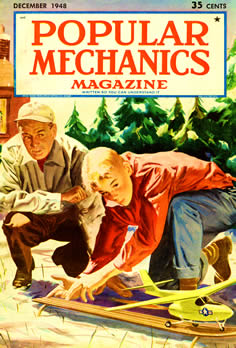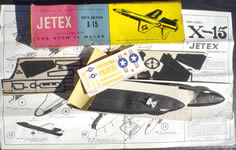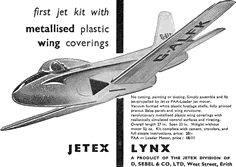|
|
|
|||
|
|
||||
|
|
||||
| The (Jet)X Files | ||||
|
|
HOME | SITE MAP | FORUM | CONTACT |
|
||
|
ABOUT | MOTORS | MODELS | ARCHIVE | HISTORY | STORE | FAQ | LINKS
|
|
|
|
|
|
|||||||||||||||||||||||||||||||||||||||||||||||||||||||||||||||||||||
|
The (Jet)X Files 10 (October 2003)
by Roger Simmonds Reprinted from SAM 35 Speaks, October 2003 (with corrections by author) Rocket Plane Histories The invention of a practical solid fuel reusable rocket motor was primarily a result of Bill Wilmot's and Joe Mansour's genius, modelling experience, business acumen and wartime experiments, but I hope they were at least encouraged, if not inspired, by the activities of earlier UK rocket enthusiasts such as Howard Boys. It should not of course be forgotten that many other countries have interesting "pre-Jetex" histories and their own pantheon of reactionary eccentrics. The USA in particular had many rocket pioneers (including, of course Robert Goddard) and several designs for (solid) rocket powered models were published in America between 1930 and 1948. Joe Ott's rather crude "Rocket-ship no 6" [above right] appeared in Model Airplanes, Building and flying (1931), and a more advanced and nicely proportioned model appeared in Modern Mechanix and Inventions (1933) [Dick Cole's Rocket Plane, right]. This "Plane on Long Flights" [sic] reflected a common characteristic of inventors, a hubris that makes them devise clever refinements for their creations so that they become difficult, if not impossible, for the average mortal. The modified 'July Fourth' rocket was nicely positioned under the wing and attached by elastic bands, but there was a release mechanism that, according to the plan, "Drops Rocket when It Burns Out at Height of Flight" [sic]. The designer's eccentricities obviously extended to a novel use of the upper case. Tom Engleman's altogether more practicable "Spitfire" design [right] appeared in Model Airplane News, September 1941. This was powered by a "five or ten-cent two-ounce rocket" (I think this refers to the thrust of the motor). The description continues, "[It] climbs to an altitude of 150 ft, turning in flights of over one minute … after ignition of the rocket the ship pauses on the runway for about four seconds and then WHOOOOOSH!! Your next glimpse of the model is as it starts its flat spiral glide overhead". This is enthusiastic writing, a real contrast to the somewhat dry and academic text of UK magazines of the time. Suitably proportioned, the Spitfire will make a nice Rapier model, as will N. Negri's twin boom design, which appeared in Frank Zaic's more sober book on glider design (1944). I believe Negri's model was an indigenous design, in contrast to the Haase's model (which appeared in this same book) discussed last month. |

- Aeromodeller, Jan. 1993 (p. 13)
 Dick Cole's Rocket Plane
-
Modern Mechanix and Inventions,
Jan. 1933 (p. 130) 
- Model Airplane News, Sep. 1941
|
|||||||||||||||||||||||||||||||||||||||||||||||||||||||||||||||||||||
|
Lastly, Popular Mechanics Magazine (December 1948) included a well illustrated article featuring the "Strato-Rocket" design by a Mr Roswell Brown [right]. This was a most sophisticated model, which featured a take-off dolly, and a six ounce rocket, "held by a string to a spring" … this is burned after the charge is spent and the spring kicks the rocket … against the bomb bay doors which open to expel the rocket"! This model was featured on the magazine's cover in full if garish colour [below right], so we may surmise that rocket power was now respectable in America! These are only a few examples, of course; it would need a dedicated historian to do justice to the history of rocket propelled models in the USA. France not only had Monsieur Bougeret (who was, the editor points out, a well-known contest flyer of the period), but also a M. L Dargère, whose "Sparkling Star" appeared in Le Modèle Réduit d'Avion (1946). Tom Andrews sent me the plan of this quite large (40" span, 27" length) futuristic design, which probably needed one of Bougeret's "7 ounce" motors (or fusées) to get it off the ground. 
- Modèle Réduit d'Avion, 1946
Jetex power was very popular in Scandinavia. Sigurd Isacson imported kits and motors, and also produced a number of duration and profile designs (for example a Hunter and Lansen). However, Sweden also had its own pre-Jetex pioneer in Lennarth Larsson, who began experimenting with rockets and aeroplanes in 1948. Lennarth was at the Old Warden SAM 35 Gala, and he shared his story with us. |

-
Popular Mechanics, Dec. 1948
(art: Wendell King) |
|||||||||||||||||||||||||||||||||||||||||||||||||||||||||||||||||||||
|
Stimulated by photos of an Me 163 (he didn't have a plan), Lennarth attached a
balsa fin and wing to a wooden tube (previously used for storing sugar, 10cm
long and 1.5 cm diameter) so that, "[it] matched the 40-50° sweep-back
profile of the Komet from the side and top". This rudimentary model was powered
by a stripped-down skyrocket and launched from wooden rails. When fired off,
"it just flew so wonderful, and glided in wide circles … I did not know
what I was doing … I had no aerodynamic knowledge … I didn't
balance it at all … it was beginner's luck". The similarity to
Howard Boys' initial activities is remarkable. When Jetex arrived in
Sweden Lennarth tried a profile model, which was less successful, but he later
built many Jetex models in the early fifties. Lennarth had been unaware of
Rapier motors, so these were something of a revelation to him. I hope he bought
a box or two for his Aerographics Me 163. He has now joined SAM 35 and I hope he can help me to track down some articles by Sigurd Isacson in Teknik för Alla ('Technology for all'). Isacson published some early Wilmot Mansour plans such as the Flying Wing and Vampire as well as his own designs like the Sabre, MiG 15 and Draken. I believe there was also a Hunter. If anyone knows anything about any of these models please let me know. |
||||||||||||||||||||||||||||||||||||||||||||||||||||||||||||||||||||||
|
More Tailored Models I have already had some feedback about last month's Fairey Delta 2 special offer. Ron Gray, who worked for Sebel at the time, recalled a prototype being launched from an office window. It glided (after a fashion) to a distant rooftop. He says the model was "a beast to build, and you really needed a degree in aerodynamics to make and fly it". This is somewhat discouraging, if indicative of what Sebel thought Eagle readers were capable. Griff Ingram passed one of the 'kits' to Ron. Ron now believes this isn't perhaps the model he remembers, which he now believes was actually a TSR-2! Now this really would be a challenge, in any format, let alone cardboard, and I will try to find out more about this second Sebel promotional model. Ron Pasco was probably the designer and fabricator of these models. Ron took over from Mike Ingram when Sebel moved to Erith, and it was he who was responsible for the later 'Mach 1' Crusader and Starfighter, and also for three late models in the 'Tailored' tradition that appeared in 1960, viz., the Sea Vixen, Temco TT-1 and X-15. These models were simpler and less ambitious than previous Tailored models, and good flying characteristics were obviously a design priority. In contrast to other tailored models the motor was not enclosed; indeed there was no trough or any attempt to conceal the Atom 35 at all. This does detract from their elegant (though no more semi scale) appearance. |
||||||||||||||||||||||||||||||||||||||||||||||||||||||||||||||||||||||
|
I remember the X-15
as a most desirable kit [right] on a distant shelf in the model shop. I never did
pluck up courage to look at it properly, as it was then, alas, way beyond
my purse. Over the years I had forgotten who made it, and, hoping to track
the model down, I recently perused the KeilKraft, Skyleada, Aristocraft,
Berkeley and Cleveland archives to no avail. However, life is full of surprises
and a Sebel (of course!) X-15
kit was recently put up for sale on an Internet auction site. Ironically,
it could well have been way beyond my purse again, as some of the prices sellers
ask and buyers will pay for Jetex artefacts can be much too high, even for
Rapier addicts used to seeing their money burn. However, on this occasion
the seller was a real gentleman, money changed hands, and I was now able to
compare the X-15,
TT-1 and Sea Vixen kits at first hand. As with all Sebel products, all three were beautifully presented, "complete with plan, simple instructions, cement, transfers etc", as it says on the box. I might argue about the simplicity of the instructions, but they were definitely comprehensive. The all-sheet flying surfaces were die cut and stained (similar to Sebel profile models), and all other wooden parts were ready shaped. There was even a motor mount and a wretched (and to modern eyes toxic) square of asbestos paper. The most appealing box contents, however, were undoubtedly the coloured fuselage shells. These were moulded cardboard, and as nicely detailed and attractive in their way as those of the older 'FROG' rubber powered models. A review of these kits in Model Aircraft (November 1960), says, "We found the construction a bit "fiddley" and a beginner may well be discouraged by this before the model is completed. However, for those who "stay with it" the finished job is quite attractive. They certainly fly well … they are ideal for indoor R.T.P. club meetings during the winter months". I do not remember any examples of these models on the flying field, or R.T.P. in the clubroom for that matter (and this was a club which numbered Rollie Lelliot amongst its members), so perhaps they came too late to more than slow the waning interest in Jetex in the UK, and a lot were exported. |

- Ken Butterfield
|
|||||||||||||||||||||||||||||||||||||||||||||||||||||||||||||||||||||
|
Sebel
continued to produce new kits, however, and one of Bert Judge's last
designs, what might be called the “last of the Tailored models”,
was the most elegant and desirable Sebel
Lynx for
PAA Loader (1960) [right].
This design was strangely reminiscent of the much earlier
Wilmot Mansour Voodoo, the first model to feature a fuselage of moulded balsa
shells and receive the 'Tailored' appellation. The Lynx's
construction was actually very similar to the Jetmaster powered Swift
and Hunter,
except that the fuselage was made by joining two light plastic (not balsa)
shells. The photo [below right] gives the impression that the motor was neither augmented nor internal (perhaps it was thought the plastic would melt), and was instead, like the Voodoo, mounted in a shallow trough below the wings. Though the wings were built up,
they were covered in a glossy "silverised" plastic, which was, perhaps, an
early example of Mylar. There was an interesting and favourable review of this innovative model in the October 1960 issue of the RAF Flying Review by Geoffrey Norris, Assistant Editor (and later, Editor). Commenting on the plastic fuselage, he says, “The Lynx deserves some attention. The fuselage and fin are moulded in two separate halves in a rather flimsy plastic strengthened at strategic points by a balsa framework. The model seems to have overcome all the snags of earlier attempts in that it is strong and light. It also incorporates a smooth, realistic finish usually associated with the more legitimate [?] plastic kits – and it flies well." Norris concludes, "a plastic modeller might think that he has rather a lot to do before he can get down to the serious business of finishing the decoration of the aircraft. The finished kit is, indeed, very handsome, and it makes the task of adding embellishments very much worthwhile.” (The writing style has the RHW aura of erudition.) I do not recall seeing any review in Aeromodeller or Model Aircraft. Can any reader help with a plan and more details of this lovely model? |

-
Aeromodeller, Dec. 1960 (p. 626)
 
- Roger Simmonds
|
|||||||||||||||||||||||||||||||||||||||||||||||||||||||||||||||||||||
|
|
||||||||||||||||||||||||||||||||||||||||||||||||||||||||||||||||||||||
|
|
|
|||||||||||||||||||||||||||||||||||||||||||||||||||||||||||||||||||||
|
|
|
|
|
|
|
|
Acknowledgements - Article: Roger Simmonds - Illustrations: Roger Simmonds, Tom Andrews, Ken Butterfield, Bill Henderson, Ben Nead, MAAC archives via Bill Henderson, Jason P Wilbourn |
|
|
|
|
ABOUT | MOTORS | MODELS | ARCHIVE | HISTORY | STORE | FAQ | LINKS |
|
|
Terms of Use
|
Queries? Corrections? Additions?
Please
contact us.
|
|